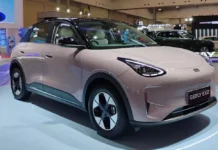Introducing in late October 2023, the new generation of Honda CR-V continues to surprise users with a starting price of 1,109 billion VND and a maximum of 1,31 billion VND. Among them, the C-segment crossover for the first time has a hybrid version (e:HEV) in Vietnam, with a selling price set at 1,259 billion VND.

Specifically, the e:HEV version of the Honda CR-V 2024 is fully imported from Thailand.
The above price range of the Honda CR-V 2024 has become a hot topic of debate for Vietnamese users. The reaction of the majority is relatively negative, with some even claiming that the Japanese automaker is experiencing a “virtual price” phenomenon as the price of the new CR-V is not only the most expensive in the C-SUV segment but also on par with some D-SUV models like the Hyundai Santa Fe (1,029-1,369 billion VND).

In the international market, the price of the Honda CR-V is even close to luxury cars like the Lexus NX.
Nevertheless, there is still a segment of customers who are interested in and curious about the new generation of the CR-V. For many financially capable individuals, unique choices beyond the norm always have a certain appeal, especially when Honda cars are highly regarded for their driving experience.
With that mindset in mind, we had a short period of time to experience the operation of the Honda CR-V 2024 on the road, specifically the e:HEV version.

The exterior of the Honda CR-V e:HEV stands out from the regular versions with black details from the RS package, such as alloy wheels, rearview mirrors, RS logo.
Most notable upgrades compared to the previous generation
Ignoring the new features and designs, the aspect that fans of the CR-V series are interested in the new generation is the driving performance. Among them, the issue of noise insulation, which many customers complained about in the previous generation, has been addressed by the Japanese automaker.

The interior of the Honda CR-V is eye-catching and sportier, with many similarities to the Civic.
In real-world urban conditions, the new generation of the CR-V has good environmental noise insulation, especially with the e:HEV version that uses electric motors at low speeds.
At high speeds with an average speed of about 100 km/h, there is almost no noise from the suspension system entering the cabin, providing a more pleasant driving experience.

The panoramic sunroof is only available on the L AWD and e:HEV versions of the Honda CR-V 2024.
The sound system of the Honda CR-V 2024 has also received noticeable upgrades, specifically the inclusion of a 12-speaker Bose system, but only available on the e:HEV version. The quality of this speaker system is quite good, suitable for mainstream users, thanks to its deep bass, although for more discerning customers, the treble may be a bit lacking.

The Bose speakers are placed in various positions, including the A-pillar, providing an interesting audio experience for users.
Fuel-efficient yet enjoyable hybrid engine
Hybrid cars are no longer unfamiliar to Vietnamese users. However, the introduction of a hybrid powertrain on a Honda model for the first time still brings significant attention.

The hybrid powertrain on the Honda CR-V e:HEV consists of a 2.0L gasoline engine with 145 horsepower and 183 Nm, combined with 2 electric motors, resulting in a total output of 204 horsepower.
Unlike conventional hybrids with only one electric motor combined with a gasoline engine, the configuration of the Honda CR-V e:HEV includes two electric motors. This difference gives the vehicle flexible driving capabilities, switching between pure electric, series hybrid, or parallel hybrid modes.
This is also why the CR-V e:HEV does not have an EV Mode button commonly found on Toyota hybrids.

The Honda CR-V e:HEV 2024 only has 3 driving modes: Eco, Normal, and Sport.
At low speeds (below 60 km/h), the vehicle operates solely on electric motors, providing a smooth driving experience similar to fully-electric cars.
When the driver presses the accelerator pedal harder for acceleration or overtaking, the gasoline engine will be activated but not used as a primary driving source, instead acting as a generator to charge the battery before distributing energy to the electric motors. This operating mode is called series hybrid and is similar to the e-POWER technology found in Nissan Kicks.
At high speeds (from 70 km/h onwards), the vehicle operates in parallel hybrid mode. At this point, the gasoline engine becomes the primary driving source, while the electric motor acts as a supporting unit.

The vehicle’s control system actively calculates to optimize the gasoline engine and electric motor, selecting the best activation time to achieve fuel efficiency.
With this configuration, the Honda CR-V e:HEV provides more exciting driving experiences compared to the regular versions, despite only being equipped with a front-wheel drive system. The gasoline-only variants of this crossover use a turbocharged 1.5L engine, resulting in some initial RPM lag.
The operation of the hybrid powertrain is not the only factor that makes this model highly regarded by driving enthusiasts. The suspension system and Honda’s handling setup also contribute positively.

The steering wheel of the CR-V e:HEV has a sufficient firmness, with adjustable weight depending on the driving mode.
When traveling on roads with speed bumps, the suspension system of the CR-V e:HEV quickly dampens the impact while still being relatively smooth. In sharp turns, the body of the vehicle still has a slight roll but quickly stabilizes.

The response from the suspension system to the steering wheel is quite accurate, providing confidence in high-speed maneuvering.
The Honda CR-V e:HEV is the only version fully imported from Thailand. However, when it arrives in Vietnam, the all-wheel drive (AWD) system is removed and replaced with a front-wheel drive system.
Many users believe that it is a disappointing move. However, real-world experience shows that the front-wheel drive system can still meet up to 90% of regular needs. Additionally, if the AWD system is included, the CR-V e:HEV would have a price tag close to 1.4 billion VND, making it less accessible to the majority of customers.
In addition to the suspension system and steering wheel, the Dunlop Sport Maxx tires (only available on the e:HEV version) also contribute significantly to the sporty driving experience. This is a specialized tire line that is usually found on high-performance models.
In terms of fuel consumption, according to our assessment, the Honda CR-V e:HEV consumes approximately 5.5 liters per 100 km of mixed driving, which is close to the manufacturer’s official rating of 5.2 liters/100 km.
When the vehicle is stopped, the gasoline engine will only activate to charge the electric motor’s battery and then shut off, according to the handling system’s evaluation.
Active safety features and improved interior space
The Honda CR-V 2024 comes equipped with the Honda Sensing package on all versions. This active safety system includes features such as collision mitigation braking system (CMBS), adaptive cruise control with low-speed follow, road departure mitigation (RDM), lane keeping assist system (LKAS), automatic high beams (AHB), and low-speed following (LCDN).
The e:HEV version stands out from the regular versions with intelligent adaptive headlights (ADB).
Although it does not have blind-spot warning commonly found on similarly-sized models, the sensor system of the Honda CR-V e:HEV works effectively, reacting fully to various environmental situations. In fact, the warning sounds can be quite annoying to some users due to the system’s constant alerts.
The 360-degree camera of the vehicle is quite clear.
However, the vehicle’s safety system still has some areas that need improvement. For example, the collision mitigation braking system will emit an audible warning three times, and if the driver does not apply the brakes, the system will intervene and actively brake. However, the distance between the vehicle and the object in front is quite close, which can be startling.
The Lane Watch camera is somewhat of a special feature of Honda vehicles. The display quality is not as sharp as the 360-degree camera but is quite smooth.
Next, the lane keeping assist system only activates at speeds above 70 km/h, according to our test. At speeds around 50-60 km/h, the lane departure mitigation function operates, causing the steering wheel to jerk slightly to remind the driver to steer.
This is not a major issue, but for many users who prefer a “relaxed” driving experience, it would be better if the lane keeping assist system was activated at lower speeds.
The head-up display (HUD) is only available on the L AWD and e:HEV versions of the Honda CR-V 2024.
Additional images and information of the Honda CR-V e:HEV:
The overall dimensions of the vehicle (Length x Width x Height) are 4,691 x 1,866 x 1,681 (mm).
The Lane Watch blind spot camera is only available on the right side mirror.
The steering wheel is equipped with various function adjustment buttons and an easy-to-use scroll wheel.
The steering wheel has paddle shifters.
The digital instrument cluster behind the steering wheel has a size of 10.2 inches.
The infotainment screen has a size of 9 inches and supports wireless Apple CarPlay, but requires a cable for Android Auto.
The vehicle has dual-zone automatic climate control, remote start, push-button start, and wireless phone charging capabilities.
The area of the air conditioning vents for the second row has 2 USB-C charging ports.
With the 5-seat configuration, the second row of the Honda CR-V e:HEV has spacious legroom, and the recline angle is relatively comfortable.
The Honda CR-V e:HEV only has 5 seats. The front seats are both power-adjustable.
With the 5-seat configuration, the second row of the Honda CR-V e:HEV has ample legroom, and the seat recline angle is quite comfortable.





























![[CAR REVIEW] Honda City 2023: Easily Satisfying Consumers](https://vnauto.net/wp-content/uploads/2023/10/xehay-hondacity-26092023-1-150x150.jpg)

















